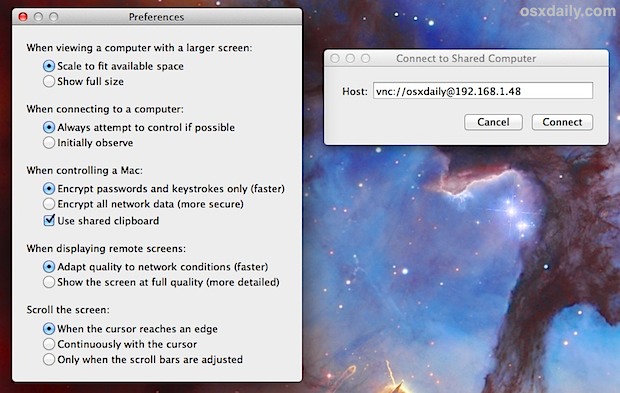 Screen Sharing in Mac OS X allows you to set up a Mac so that it can be connected to remotely through the VNC protocol, with the full screen being both visible and usable to the connected user. As you may have guessed, this means Mac OS X has a built-in VNC client, and not only is it able to connect to Macs running the VNC server (called Screen Sharing in OS X), but it can also connect to any Windows or Linux machine running a VNC server as well.
Screen Sharing in Mac OS X allows you to set up a Mac so that it can be connected to remotely through the VNC protocol, with the full screen being both visible and usable to the connected user. As you may have guessed, this means Mac OS X has a built-in VNC client, and not only is it able to connect to Macs running the VNC server (called Screen Sharing in OS X), but it can also connect to any Windows or Linux machine running a VNC server as well.
If you use VNC to connect to remote computers often, you might want to create an easier way to access the mostly hidden Screen Sharing app.
Create a Shortcut for the Screen Sharing VNC Client in OS X
This is the easiest way to create a simple shortcut:
From the OS X Finder, hit Command+Shift+G to summon the “Go to Folder” window and enter the following path:
/System/Library/CoreServices/

Locate the “Screen Sharing” app contained in the CoreServices directory, then drag & drop it to the Dock or to Launchpad
For demonstration purposes, we went with a shortcut placed into Launchpad:

You could alternatively make an alias and place it in the /Applications folder or elsewhere, but usually the Dock or Launchpad is sufficient enough. It can now be found in Launchpad through search, though unless the app is placed in /Applications/ it will still not be found in the wider Spotlight search.

Now with the shortcut created, you can just launch the app and enter the remote hosts IP, host name, or you can use the common notation of specifying a username (and password, though thats bad practice to expose passwords in plain text) with IP and protocol like so: vnc://username:password@IP.address

This is an alternative to using the the “Connect to Server” keyboard shortcut or the Safari launch approach.
As mentioned, the hidden Screen Sharing app is a complete VNC client, and though it’s not necessarily the most full featured app in the world it is more than adequate for connecting to and controlling any remote machine running a VNC server, whether that’s another Mac with Screen Sharing enabled, or even a Windows or Linux box. There are a variety of Preference options available, including the ability to encrypt all network data between the connected machines, toggle whether or not to control or observe the connected computer, scale the screen or show the connected machines in full size, adjust the quality based on the network connections, and whether or not to scroll around on the screen.

One particularly great feature of the newer versions of this Screen Sharing app in OS X is the ability to transfer files from Mac to Mac just by dragging and dropping them between the connected screens, giving you simple remote file access through the familiar user friendly interface of the Finder, if you use that often then this app shortcut will probably be particularly helpful to you.
Do note that Screen Sharing.app is simply a client, and if you’re looking to configure the server end of things you’ll need to set up remote Screen Sharing through OS X System Preferences to enable the VNC server on a Mac. Once that is enabled, it allows you to connect to a Mac remotely and control it’s screen from other Macs, Linux, Windows, even an iPhone or iPad as long as it has a VNC client.